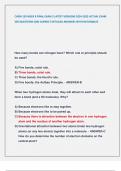CHEM 120 WEEK 8 FINAL EXAM 2 LATEST VERSIONS 2024-2025 ACTUAL EXAM
250 QUESTIONS AND CORRECT DETAILED ANSWERS WITH RATIONALES
How many bonds can nitrogen have? Which rule or principle should
be used?
A) Five bonds; octet rule.
B) Three bonds; octet rule.
C) Three bonds; the Hund's rule.
D) Five bonds; the Aufbau Principle. - ANSWER-B
When two hydrogen atoms meet, they will attract to each other and
form a bond (and a H2 molecule). Why?
A) Because electrons like to stay together.
B) Because electrons like to be paired up.
C) Because there is attraction between the electron in one hydrogen
atom and the nucleus of another hydrogen atom.
D) Gravitational attraction between two atoms binds two hydrogen
atoms (or any two atoms) together into a molecule. - ANSWER-C
How do you determine the number of electron domains on the
central atom?
,A) Draw Lewis structure of the compound, then add up the numbers
of lone electron pair, single bond, double bond, and triple bond.
B) The # of electron domains = the # of valence electrons
C) The # of electron domains = the number of atoms the central atom
is bonded to.
D) The # of electron domains = the # of valence electrons divided by 2
- ANSWER-A
Indicate partial charges on each atom of the following two bonds: CBr
and O-N.
A) Carbon has partial negative charge and bromine has partial
positive charge; both oxygen and nitrogen have no charge.
B) Carbon has partial positive charge and bromine has partial
negative charge; oxygen has partial negative charge and nitrogen has
partial positive charge.
C) Carbon has partial negative charge and bromine has partial
positive charge; oxygen has partial positive charge and nitrogen has
partial negative charge.
D) Carbon has partial positive charge and bromine has partial
negative charge; oxygen has partial positive charge and nitrogen has
partial negative charge. - ANSWER-B
In which of the above structures, the nitrogen atom carries a negative
formal charge?
A) a
,B) b
C) c
D) d - ANSWER-A
In which of the above Lewis structures, the oxygen atom carries a
positive formal charge?
A) a
B) b,c
C) a,d
D) c
E) d - ANSWER-B
Which of the following compounds exists?
A) CH3CH3CH3
B) (CH3) 2CCH3
C) CH3CHCH2CH3
D) (CH3)2CHCH3 - ANSWER-D
Indicate hybridization of oxygen atom in the following compounds:
H2O, H2C=O, H3O+, HO-, and CO
A) sp3, sp3, sp3, sp3, sp B) sp3, sp2, sp2, sp, sp
C) sp3, sp2, sp3, sp3, sp D) sp, sp2, sp2, sp, sp - ANSWER-C
Indicate hybridization of carbon in the above compounds.
A) sp3, sp2, sp3, sp2
, B) sp3, sp2, sp2, sp2
C) sp3, sp3, sp3, sp2
D) sp3, sp3, sp3, sp3 - ANSWER-A
What is the bond angle in a perfect tetrahedron molecule like CH4?
A) 120
B) 0
C) 180
D) 109.5 - ANSWER-D
When SO3 reacts water, sulfuric acid (H2SO4) is formed. Is SO3 a
BrØnsted-Lowry acid?
A) No, it is not a BrØnsted-Lowry acid.
B) Yes, it is a BrØnsted-Lowry acid. - ANSWER-A
Conjugate acid and base is a concept unique to BrØnsted-Lowry
acids and bases. Which of the pairs below are not conjugate acid and
base?
a. H2SO4 and SO42- b. H2CO3, CO2 c. HCl and Cl2 d. H3O+ and HO- e.
HBr and Br-
A) a,b,c B) a,b,c,d C) a,b D) a,b,c,d,e E) e - ANSWER-B
What is the pH value of an acidic solution with a proton molar
concentration of 10^-3?
A) 0.001 B) 0.003 C) 3 D) -3 - ANSWER-C





